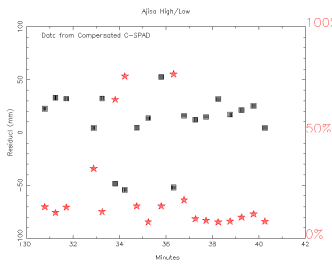|
||||||||||
|
|
|
|
|
|
|
|||||
|---|---|---|---|---|---|---|---|---|---|---|
|
|
||||||||||
|
Satellite
signatures
have
become an
urgent issue in the advancement toward millimetre range measrements. All range measurements require a correction from the retroreflector target array to the centre- of-mass of the satellite. This correction depends, however, on where on the target array the measurement is made. A high energy observation will relate predominantly to the front of the target. A low energy observation, however, could be made from anywhere on the array. These two measurements will require different centre-of-mass corrections.  At the 2005 Workshop we would like to invite stations to report on observation energy levels during their routine operation. In particular we would request that stations present experimental results from High/Low energy tests. At the 14th International Laser Ranging Conference, results were presented that showed a difference in range measurement at high and low levels of return energy and included the plot on the left. The black squares on the plot represent normal point residuals over a pass and the red stars indicate the level of return energy. At high levels of return energy the plot contains offset residuals due to the size of the Ajisai satellite. The SLR system at Herstmonceux automatically controls return energy and maintains it at a low level. This is done using a wheel that adjusts the neutral density filteration according to return energy. This pass in the above plot was observed mostly at a low return enery. By removing all of the nuetral density filtration, the system can be forced to observe a satellite at high energy. This is done twice on this plot. The pass data is then reduced using the low energy data so that the high energy data results in large residuals. For the smaller and higher Lageos satellites these energy-dependent effects are much reduced, with theory predicting high-low energy range differences of up to about 5mm. However, for these satellites, it is even more important that high-low measurements are made in order to understand fully the effects for each station.
. |
||||||||||
 |
||||||||||







